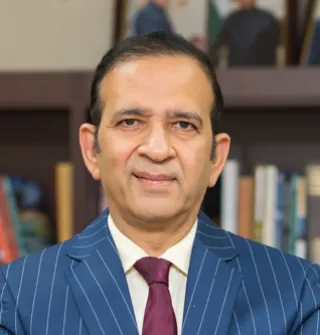-
CENTRES
Progammes & Centres
Location

Image Source: Getty
A lush meadow in Pahalgam was soaked in innocent blood this week, marking the most painful terrorist blow to India since 2008. As investigators confirmed Pakistan’s role in the massacre, 22/4 became another grim reminder that its western neighbour remains India’s primary adversary. Strategic neglect is not an option.
Pahalgam (2025) has joined a dismal calendar of 21st century tragedies: Chettisinghpura (2000), the Parliament attack (2001), Kaluchak (2002), Mumbai (2008), Uri (2016), and Pulwama (2019), each a shocking act of violence, designed to provoke and destabilise. India’s punitive strikes in Uri and Balakot did establish a new security paradigm. Coupled with the revocation of Jammu & Kashmir’s special status in 2019, the expectation was that India had set up credible deterrence against cross-border terror, triggering a peace dividend that would allow a political process to heal Kashmir. That fragile peace did hold—for a while. But Pahalgam 2025 now raises a sobering question: Has the deterrence eroded, or were deeper structural shifts at play?
So what changed? The world. And more importantly, Pakistan.
Several factors have altered the strategic balance in the region. Jammu and Kashmir has been more fully integrated into India, with political processes nudging it toward normalcy. Elections have been held. Tourism flourished. And yet, the geopolitical environment surrounding India has grown more perilous.
To the north, China’s 2020 incursion into Ladakh marked a significant escalation, though recent disengagement offers a glimmer of relief. Elsewhere, global conflicts between neighbours —from Gaza to Ukraine—have altered threat perceptions and consumed international attention. A disruptive White House has left traditional security assumptions in flux. All this enters Pakistan’s calculus.
Most crucially, changes within Pakistan have increased its hostility to India. General Asim Munir, under whose watch as ISI chief the Pulwama attack occurred, took over as army chief in 2022, to preside over a dysfunctional nation. An economy in meltdown, an incarcerated popular leader, and public hatred of the military establishment have produced a volatile brew.
For many Pakistan-watchers, a move on Kashmir was expected from the ‘hard state’ that Munir recently promised to build—and was prefigured in his rhetoric about India’s role in Balochistan and Kashmir being Pakistan’s ‘jugular vein’. As in the past, a face-off with India suits a disliked general keen to distract from domestic woes by wrapping himself in patriotism and as a defender of Pakistan’s ideological frontiers.
The Pahalgam massacre coincided with a high-level US visit to India, a traditional terrorist ploy to ‘internationalise’ Kashmir. Also, Modi was in Saudi Arabia during the Pahalgam attack, while the Pulwama attack in 2019 also unfolded during a visit by the Saudi Crown Prince to Pakistan.
India’s initial response has been measured but resolute. A meeting of the Cabinet Committee on Security—four of whose members also steered the 2019 response—approved a suite of actions including keeping in abeyance the 64-year-old Indus Waters Treaty, scaling down diplomatic missions, closing the Attari-Wagah border, and halting visas. Yet, the LoC ceasefire was not formally revoked, even though it is likely to fray. And the Kartarpur corridor for pilgrims was not shut. This signals a calibrated strategy—assertive but not reckless.
For India and the world, Pakistan’s protestations of innocence were implausible deniability, and the accusation in its echo chambers of yet another ‘false flag’ operation seemed patently absurd. Formally, Pakistan responded with predictable aggression: closing airspace to Indian aircraft, and threatening to abandon past treaties, including the Simla Agreement that stressed bilateralism.
The diplomatic moves are important. But non-kinetic actions will not restore deterrence.
India must now contemplate a fuller response that escalates the cost of aggression for Pakistan’s army. A kinetic operation—more precise, swift, and deliberate than even Balakot—may be necessary to target the infrastructure and handlers behind Pahalgam. The risks of escalation will be high but can be mitigated with gaming the Pakistan response.
Diplomatically, New Delhi will rally international support to pressure Pakistan’s military establishment. Targeted sanctions against military officials, public exposure of the ISI-terror nexus, and coordination with global partners could enhance the strategic impact. Modi’s decision to articulate India’s position in English was not accidental; it was a signal to the global community that India will act within the bounds of legitimacy but with resolve.
Simultaneously, India’s message must reach Pakistan’s military leadership clearly, of the cost of escalation and the benefits of dismantling the terror infrastructure. This quiet diplomacy, often underestimated, remains essential.
Beyond external responses, India needs to bolster domestic security, strengthening Kashmir’s counterterrorism and counter-infiltration grids. The aim is not just deterrence—but reassurance. Tourists and residents alike must feel safe. An expanded security footprint may be unavoidable in the short term. The successful elections in Jammu & Kashmir were a milestone in restoring democratic legitimacy. That momentum must continue. For any peace process to endure, it must be built on both security and inclusion.
The horror of Pahalgam is a brutal reminder that Pakistan’s internal crises can spill across its borders. Deterrence must be re-established—not merely through retaliation, but by shaping the calculus of those who believe violence in Kashmir yields rewards.
This commentary originally appeared in The Times of India.
The views expressed above belong to the author(s). ORF research and analyses now available on Telegram! Click here to access our curated content — blogs, longforms and interviews.

Ajay Bisaria is a Distinguished Fellow at ORF. He is also a strategic consultant and commentator on international affairs. He has had a distinguished diplomatic ...
Read More +